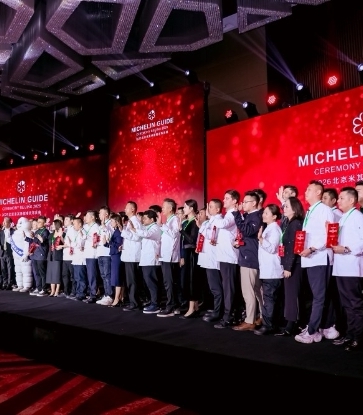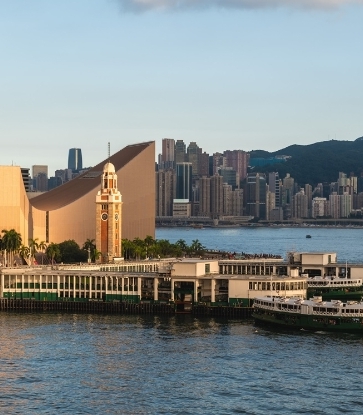“Latin America is the shelf of the world for produce,” says Ricardo Chaneton, the chef-owner of Hong Kong’s newly minted one-MICHELIN-starred Mono. “When our guests see jicama and chayote, they ask me: ‘Why do you use Chinese ingredients in the restaurant?’ I say, they are from Latin America and let me tell you the history.”
Jicama, he explains, was first brought to the Philippines by the Spaniards from South America; while chayote is a gourd native to Mesoamerica. Today, both vegetables have become a staple ingredient in Asian cuisine, mostly eaten cooked in soups and stir-frys.
“But it’s not about what’s mine or yours. Here at Mono, we want to share with you what we know, in our own words,” he shares as he passes me a blue booklet embossed with the word “Monopedia.”
“The Monopedia is a compilation of ingredients, techniques and words that you often hear, see or eat at Mono. It’s an ongoing process for us as we aim to release a new edition every year. Every time we create a new dish using new ingredients, we will update the Monopedia.” he says. Besides native Latin American produce and a “Chilli Directory,” Chaneton says that tools such as molcajete from Mexico, or pilón from Venezuela—a volcanic stone tool used to crush spices to make mole and other pastes and sauces—will be included in the Monopedia as well.

The first of its kind
Born and raised in Venezuela, Chaneton confesses that despite growing up surrounded by Latin American food, he never learned how to cook it. “Latin American cuisine is more a nostalgia and memories for me, which I interpret with my expertise in French cooking,” he says, referring to his seven-year stint at Mauro Colagreco’s three-MICHELIN-starred Mirazur.
“But I wouldn’t say I came from a very French restaurant, either. Mauro serves a very personal cuisine—his interpretation of the terroir of the place and the ingredients in his own way. So Mirazur became something with a strong identity of Mauro and his travels,” he shares. After his departure with Mirazur, Chaneton was offered the opportunity to move to Hong Kong and head up the kitchen of Petrus.
“Petrus was a very classic (French) restaurant. It was my first time doing my own cuisine under my name. Thanks to Petrus, I realised the clientele in Hong Kong was very strong. People know their food,” he remarks, adding that Hong Kong diners travel and eat at the best restaurants around the world. So when the opportunity to open a restaurant with JIA Group came knocking at his door, he decided to take a “subtle and humble” approach to the food he put on the table.
“When Mono first opened, we said the cuisine was French contemporary. The reason was that my training was French and the contemporary aspect came from the nuances of Latin American cuisine.” he shares. “We left it at that because we wanted to let people explore our cuisine and tell us what they felt it was.”
“Then the MICHELIN Guide came out in January 2021 and Mono was recommended in the Guide. I was very proud of that and the cherry on top was that our cuisine was categorised as ‘Latin American.’ For me, it was at that moment that I knew we were heading in the right direction,” he recounts.
RELATED: Ricardo Chaneton On His "Destiny" To Open Mono In Hong Kong

La Vivência
“To me, Latin American cuisine is misinterpreted in Asia, and even the world,” says Chaneton. “Latin America is almost double the size of China. But because the countries share the same history with Spaniards, Latin American people relate to each other even when they are outside of Latin America. We call this shared experience vivência.”
“We share the same language, TV show, merienda (“light meal” in Spanish), siesta (“afternoon nap” in Spanish)—certain cultural traditions are very similar. When it comes to food, we all eat the same main ingredients but some dishes are called different names.”
He uses hallaca, a traditional dish from Venezuela, as an example. “Everybody knows tamale from Mexico but you can find tamale in Bolivia, Colombia and Venezuela. Hallaca looks like a tamale but it’s 100% Venezuelan. It's a Christmas tradition that brings families together because everyone takes part in the preparation of this dish. It looks like the rice dumpling you eat at the Dragon Boat Festival.”

Another staple food from Chaneton’s hometown, arepa is considered a national dish that he describes as “a hug from your mother or grandmother.” With the traditional recipe as the base, which consists of a bread made with corn flour and stuffed with chicken salad, avocado, lime, lemon juice and coriander, Mono’s version takes it up a notch with premium ingredients such as king crab meat, Hokkaido sea urchin and caviar. “The arepa sustains many communities in Spanish culture. It is a movement, a culture, a dish that you can eat for breakfast, dinner and supper. It can be enjoyed at any moment of the day, any celebration, any occasion. Arepa is always the answer.”

But nothing brings Chaneton more pride than cacao, which Mono ferments in-house. “Cacao brought a sparkle to this restaurant during a difficult time when dinner service was closed due to Covid,” he shares. “Cacao represents a lot for Venezuelan people. It’s a fruit that brought a lot of power to the economy of Venezuela in certain times of its history.”
Earlier this year, Mono introduced trinitario, a hybrid cacao variety of Criollo and Forastero from an organic farm in Taiwan, to create a beautifully balanced chocolate blended with Ecuadorian cacao. “The Taiwanese cacao is super bitter and strong, like green banana; while Ecuadorian cacao has a lot of fruitiness. It's floral, perfumed and gives notes of tropical fruit like banana, mangosteen and lychee.”
The versatility of cacao is fully expressed in one of Mono’s signature dishes: pan-seared imperial langoustine, served on a bed of rich chocolate sauce made with langoustine head and cacao. “Cacao becomes chocolate when sugar is added. But in this dish, the sugar in the langoustine head complements the bitter taste of the cacao to make the chocolate sauce,” he explains. “The most interesting part of this dish is that we serve it with the fresh cacao fruit, which most people have never tried in their life.”
Deservingly, Mono received one MICHELIN Star in the MICHELIN Guide Hong Kong Macau 2022 and was praised by MICHELIN inspectors for delivering “bold flavours reminiscent of the vibrancy of the continent’s culture.” Ahead, Chaneton shares how it all started, the best advice he has received, and what the MICHELIN Star means to him.
When did you first hear about the MICHELIN Guide?
I used to work with a now-famous chef called Luis Martinez in Venezuela. He came back from Spain where he did an internship at a two-MICHELIN-starred restaurant. I always heard him talking about the MICHELIN star and the molecular cuisine in Spain. I thought it sounded exciting.
Which restaurant has the most influence on you?
Quique Dacosta is a restaurant that marked my life forever. I started as an intern dish washing at the restaurant. It was amazing—that adrenaline, sensation, and feeling to always push harder.
But if people ask me “How many restaurants have you worked at in your career?” There’s only one—Mirazur. When I joined Mirazur, it had one MICHELIN star. I started at Mirazur as chef de partie, and finished with what my ex-wife used to say “wife of Mauro” (chuckles). Before I left, Maruo gave me the opportunity to open Mirazur in winter—something we had never done before. We didn’t know the clientele in winter, nor were we familiar with the garden’s winter produce.
I had the helm of Mirazur for three months: my menu, my food, my concept. I recruited a winter team from zero, and two of them are still working at Mirazur. Since then, Mirazur opens in winter every year.
What’s the best advice you have received?
A chef once told me: don’t “sell a cat for a hare.” It’s a Spanish idiom that means to trick someone by giving something with less value than what they pay for. Don't lie to the guests if you run out of something. It's an amazing advice that I still carry with me every day.
What does the MICHELIN Star mean to you?
It’s a big achievement for the team, our guests and Latin American cuisine. We’re proud to cook every day. It’s a beautiful reward for the restaurant and what we represent in Asia.
How did it feel compared to when Mirazur received a MICHELIN Star?
Very similar, actually. It was a lot of work and beautiful moments. When you receive a reward after all the hard work, it makes everything worth it.
How did you celebrate?
Champagne, Mexican beer, arepas.
CONTINUE READING: More First Day Stories






















